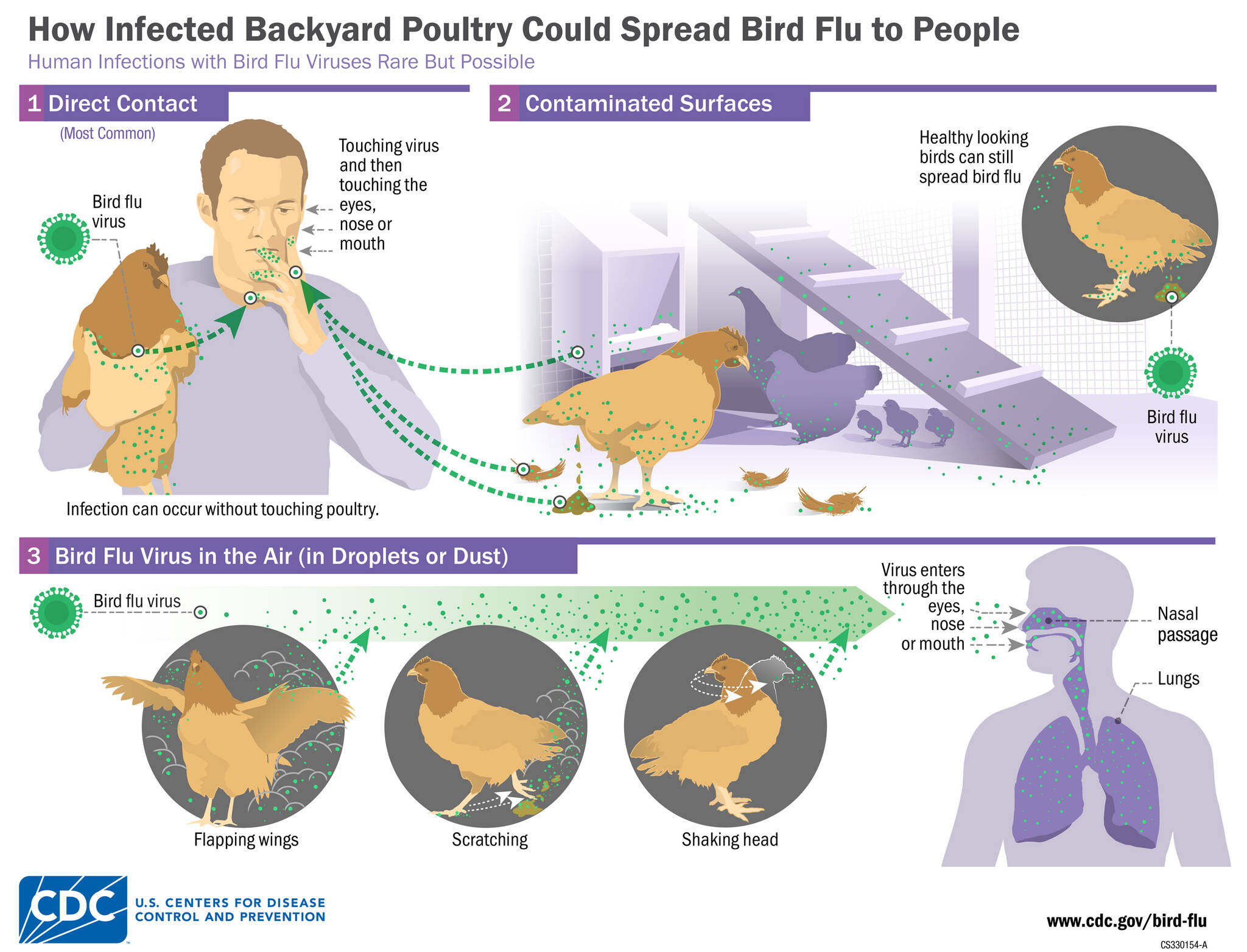Three main respiratory virus illnesses normally peak at this time of year — seasonal influenza (flu), respiratory syncytial virus (RSV), and COVID-19. That’s why public health experts call fall and winter the respiratory virus season, and so far, the pattern has been holding true.
Public Health — Seattle & King County (PHSKC) monitors infection rates for the three diseases, and has established alert levels for each. All three are at elevated levels. However, only two have hit the alert level.
• COVID remains below the PHSKC alert level at this time.
• Respiratory syncytial virus (RSV) infections are above the alert level.
• Seasonal influenza (flu) infections are well above the PHSKC alert levels. The Washington Department of Health reports that, sadly, 43 of our state’s residents have perished with lab-confirmed flu so far this season, 80% of them aged 65 and older.
Human bird flu infections
The risk of human infections from H5N1 avian influenza (bird flu) remains low right now, according to the Centers for Disease Control and Prevention (CDC). That’s primarily because the current strain of bird flu does not easily infect humans, and most cases have been traced to people exposed because they work in agriculture or have backyard chicken flocks.
However, there have been two deaths from bird flu this month in the U.S. The two bird flu deaths and nearly 100 documented bird flu cases among cattle and poultry workers have prompted worried questions from our readers.
With help from the Vashon Medical Reserve Corps, we have pulled together some information to help you understand what’s happening.
Potential for mutations
A person (or an animal) who simultaneously catches seasonal flu and bird flu could become a virus mutation cooker. The two virus strains could share genetic material and the resulting mutation could result in a more virulent strain of bird flu, one adapted to be more likely to infect humans and to spread from human to human.
So far, there have been no confirmed cases of human-to-human spread, but the potential for mutations that could lead to a human epidemic or pandemic greatly increases the importance of preventing the spread of both seasonal flu and bird flu.
Preventing seasonal flu
To prevent the spread of seasonal flu:
• Get vaccinated.
• Wear a mask in public gatherings.
• Wash your hands regularly.
• Stay home if you have upper respiratory symptoms so you don’t infect others.
• Take care to protect seniors because they are at particular risk from flu.
• If you or someone in your household is at increased risk from flu, RSV, or COVID, have a pulse oximeter at home. It will help you to know if an infection is serious.
Rapid three-in-one tests are now available for not only COVID but also types A and B seasonal flu. If you test early, you can make a significant difference in the severity and duration of symptoms.
Once a test shows positive, treatments are available for both COVID and flu. The antiviral medicine for flu should be taken as soon as possible, ideally less than 24 hours from the first symptoms appearing and no more than 48 hours. The COVID treatment must be taken within five days of first symptoms to be effective. The new three-in-one tests cost a bit more than the old COVID-only tests.
Preventing bird flu
The bird flu infection path for Vashon residents could be handling a dead bird or, more likely, an infection from chickens kept at home.
Here are some steps to protect you if you have a chicken flock:
• If possible, keep your flock isolated from wild birds.
• Wear gloves and decontaminate your boots and gloves with alcohol or bleach before and after entering your coop.
• Wash eggs and your hands after collecting eggs.
Here are some additional precautions to take in your kitchen:
• Cooking poultry and eggs to an internal temperature of 165˚F kills bacteria and viruses, including the virus that causes bird flu.
• Pasteurization of dairy products kills the bird flu virus, so public health experts are recommending that people avoid raw dairy.
• During meal preparation, keep uncooked (raw) poultry separate from cooked foods and foods that won’t be cooked.
These precautions will not only protect you against avian flu, but also protect against Salmonella and Campylobacter, which are also carried by chickens.
Detailed online bird flu info
Here are some thorough sources of online information about bird flu:
“Your Local Epidemiologist” Dr. Katelyn Jetelina blogs on human bird flu infections: tinyurl.com/BirdFluYLEinfo and tinyurl.com/YLEbirdFluFAQ.
The American Veterinary Association shares signs to watch for bird flu in pets and backyard flocks: tinyurl.com/AVMAbirdflu.
The University of Chicago School of Medicine has more information on prevention: tinyurl.com/UCbirdFlu.
A recent VashonBePrepared newsletter covered bird flu considerations: conta.cc/4gX69I1.



